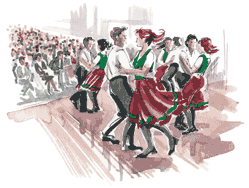 |
 | |||
 Irish DancesThere are two distinctive forms of Irish dancing; solo dances and figure dances. Solo dances are performed nowadays mainly in exhibition or competition and require a great deal of skill and years of practice. Figure dances are simple and easy to perform and require only an elementary knowledge of the most basic steps. They lend themselves well to recreational and social events, as anyone who has been to a céilí can confirm. There are three grades for beginners of Irish dance, Grade A, Grade B and Grade C. Grade A is basic steps in dance.A dancer must attain this standard to pass onto Grade B and do another test before moving onto Grade C. After reaching this standard, a dancer moves upward in age groups to Over 21 where there is no age limit.
The style to be cultivated in the solo dances is one of simplicity and natural grace. The carriage of the body should be natural, upright There are several main Irish step dances: reel, light jig, heavy jig, single jig and the hornpipe. There are many variations of these dances and each dancing school has its own version of the steps. A heavy jig is danced in an aggressive manner in heavy shoes, which produce a stamping sound. The heavy jig, Saint Patrick's Day, is the only dance all dancing schools have in common. It is a traditional set dance, with eight people in jig time and danced in heavy shoes. The derivation of the word jig has never been satisfactorily explained. Most writers of the last century held the opinion that the term jig was of Italian origin. There was indeed a type of musical measure popular in Italy during the eighteenth century termed a Giga, and most experts confirm that the Irish jig was derived from this particular type of Italian music popularised by two great Italian musicians, Corelli and Geminani. However, tunes called Irish jigs had previously been published in several editions of Playford's Dancing Master, and these booklets were published from 1650 to 1700, many years before the birth of Corelli and Geminani. The basic music defines the speed of the dance. The time of a tune is shown at the beginning of the music, a jig, for example, is in 6/8 time. The first number is the number of beats per "measure" or "bar". The second number is the basic unit for a beat. The tempo of the music determines the speed of the beat: Reel - 4/4; Jig - 6/8; Slip Jig - 9/8; Single Jig - 6/8; Hornpipe - 2/4 or 4./4 depending on how the music is written. > > > Read the next part of this article
From Irish Dance by Authur Flynn. Illustrated by Anne Farrall |
[ Back to top ]
All Material © 1999-2018 Irelandseye.com and contributors

 and relaxed. The arms and hands should be kept flat against the side. The figures and steps should be executed with accuracy and precision, but easily, without any effort. Irish figure or group dancing can be performed in a square, circle or line formation, enjoying only a few simple steps. These dances are essentially the dances of Ireland.
and relaxed. The arms and hands should be kept flat against the side. The figures and steps should be executed with accuracy and precision, but easily, without any effort. Irish figure or group dancing can be performed in a square, circle or line formation, enjoying only a few simple steps. These dances are essentially the dances of Ireland.